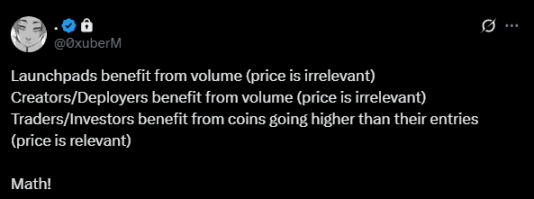This game centered around "trading volume" and "short-term speculation" will continue to consume the chips of the "suicide squad."
Written by: @0xuberM
Translated by: Saoirse, Foresight News
Editor's Note: This article analyzes the survival status of Launchpad, creators, and traders from the perspective of incentive mechanisms, pointing out that Launchpad focuses on trading volume, creators lack price support motivation, and traders have become the "suicide squad," forming a vicious cycle. Currently, only VCs and insiders have the motivation to drive up token prices, while ordinary traders are in a predicament. The article objectively presents the market situation, although it does not provide solutions, it offers an important perspective for understanding the operational logic of the crypto market. Here is the translated content:
Incentive Mechanism
The incentive mechanism is the core driving force of the world. If you want someone to do something, you just need to create an environment or scenario where they can receive rewards for completing that task—this is a basic law of human nature.
However, currently, on-chain tokens (especially those issued through Launchpad) lack the incentive mechanisms to drive price increases, and this issue urgently needs attention.
The Operational Logic of Launchpad

Yesterday, I made a sarcastic tweet related to this, and now I want to emphasize one point: token issuance platforms (Launchpad) have no motivation to raise the price of any specific token, except in certain special circumstances (which we will discuss later).
The operational model of these platforms is essentially similar to that of a casino; for them, the only important metric is "trading volume."
This is also the core reason why "permissionless issuance" and "bonding curves" (a mechanism that adjusts the relationship between asset supply, demand, and price through algorithms) have become mainstream today—just as casinos continuously introduce lottery games, platforms also hope to provide as many speculative opportunities as possible, attracting more participants by allowing a few to "hit the jackpot."
So, how do token issuance platforms profit?
It's actually quite simple: they can earn revenue just by "existing." On one hand, they provide ordinary people with permissionless token issuance channels; on the other hand, they offer speculative tools to investors through bonding curves. If they want to further expand their scale, platforms must compete for market share, and there are two common methods:
Conduct marketing activities: either spread negative news about competitors (FUD) or emphasize their own "differentiation," even if their actual business is not fundamentally different from their competitors;
Drive up the price of certain tokens: this is seen as "the best marketing method" and can quickly attract user attention.
I have observed a pattern: token issuance platforms and their teams will only fiercely compete for market share in two situations: first, when market share is taken away by competitors and needs to be reclaimed; second, when they want to deliberately suppress competitors and damage their reputation.
Interestingly, whenever these two situations occur, there are always a few tokens on the platform that start to rise in price, even reaching high valuations. They will first slow down the pace of large-scale token issuance, using "green candlesticks" (symbolizing price increases) and marketing tactics to attract users; once users are convinced that "money can be made here," they will restart large-scale token deployment, significantly increasing trading volume—this is not a critique, just an objective observation.
To be honest, if I were a team member of a token issuance platform, I might adopt the same strategy. After all, the platform is essentially a commercial entity, and the core goal of business is to maximize profits.
Creators' Behavioral Tendencies
Like token issuance platforms, creators (such as streamers) also have no motivation to raise the price of the tokens they issue. Currently, the revenue mechanism for creators is highly similar to the "permissionless issuance" model—this model benefits creators directly, just as it benefits "frequent token issuers."
You may often hear creators say, "Look, I can earn so much money just by turning on my camera!" They attract more creators to join in this way, and more creators mean more token issuance, leading to more speculative opportunities.
For creators, the logic of profit is equally simple: just "exist"—turn on the camera, issue a token for speculation, and they can earn revenue. Of course, if they want to make big money, they do need to persist in the long term, but even so, there is no guarantee of long-term success.
After all, in the cryptocurrency field, user attention is fleeting, and long-term success is inherently filled with uncertainty. In this environment, creators are easily inclined to think, "I'll make a quick buck and leave," which is actually an inevitable result of the incentive mechanism.
Traders: The "Trench" and "Suicide Squad" of the Crypto Market
So what about us traders? What is our incentive mechanism? What drives us to do what?
The answer is harsh: we are incentivized to "undermine each other." After all, the "trench" of the crypto market was dug by us (never forget this). The meanings of "trench" and "suicide squad" are also clear—ordinary traders like you and me are essentially "sacrificial cannon fodder," soldiers standing at the forefront of the market.
Since no party has the motivation to keep the price of a certain asset rising in the long term, we can only participate in this "game" in a more brutal way. There is no "player versus environment (PVE)," only competition and mutual harvesting.
Because the price increase potential of tokens is limited, we have to adopt some aggressive means to enhance our profit probability, such as locking in 10% of the supply of a certain token in advance with multiple wallets (i.e., "multi-wallet pre-staking"). In this market, "timing" is crucial—you must be early enough, or you may become someone else's "exit liquidity," ruthlessly harvested.
You might ask: How can traders make a profit? The answer is: we must pay more than others. Unlike token issuance platforms and creators who "profit easily," we need to continuously improve our skills, accumulate industry influence, cultivate judgment, expand our network, and keep up with real-time information across multiple fields—only by doing this can we have a chance to make money in the market.
Even when encountering tokens that rise sharply in the short term (like some recent CCM tokens), we still lack the motivation to hold them long-term because new "speculative opportunities" (like new lotteries) will soon emerge. The "machine" of this market must continuously produce "lotteries" to keep running.
And with each new opportunity that arises, it is accompanied by the losses of many traders, just like the trenches in reality are filled with the bodies of the fallen. For example, for every account that profits through the Axiom platform, there are hundreds of accounts whose portfolios have been wiped out.
It may sound like I'm complaining, but I am also a participant in this "game," so to put it positively, I might be considered a "hypocrite."
Now I have three thoughts: perhaps I should "adapt" to the current market rules? Or perhaps I should completely withdraw from this game? (Unfortunately, I am not someone who gives up easily) Or perhaps I should explore other fields? (Actually, I am already doing this)
Reflections on Market Cycles and Solutions
Will this "game" continue forever? I don't think so. History has repeatedly proven that this vicious cycle will eventually end in one way: winners continue to profit, losers are constantly eliminated; until a certain point, when there are no new "losers" in the market, the former winners will become the new losers.
And when everyone is exhausted and chooses to exit, those token issuance platforms will reappear, launching a few "high-end new lotteries," once again attracting everyone to participate—this is like "the snake eating its tail," forming an unbreakable closed loop.

Speaking of this, there is an interesting phenomenon: the tokens that have performed well recently are almost all those that were not issued through bonding curves, but rather projects where "a large number of tokens are locked by insiders"—we even jokingly refer to this situation as "violating regulations."
Why is this the case? The core still lies in the incentive mechanism. Currently, in the cryptocurrency field, the only ones motivated to drive token prices up in the long term are venture capital (VC) teams and project insiders—because only with long-term price increases can they sell at higher valuations when the tokens unlock, reaping huge profits.
Ironically, the traders who are currently "winning big" in the market are precisely those who purchased "poor-quality assets bundled by VCs"—and this was originally a problem that the bonding curve model aimed to solve.
So, what is the solution? To be honest, I am not sure. But one thing is clear: if a project team wants their token to succeed, they cannot risk issuing it through bonding curves—otherwise, it could lead to a situation where "a 17-year-old uses Axiom's multi-wallet to seize 10% of the token supply."
As an on-chain trader, I am more aware that the "expected value (EV)" of participating in this "game" is becoming increasingly low. Regardless, the market must change, and the incentive mechanism must be adjusted—otherwise, this cycle will only continue to repeat.
I do not have ready-made solutions, only some preliminary thoughts, and I am not sure if these ideas are feasible in practice. I do not blame anyone for the current situation; it is merely an inevitable result under the existing incentive mechanism. Unless some institution or model can completely break the current pattern, it is difficult for the incentive mechanism to undergo substantial changes.
I am just an active trader and a user of token issuance platforms. I write down these thoughts in hopes that the platform team can see them (although with each experience of this cycle, my hope diminishes a bit, and I think others may feel the same).
As people often say: everyone is for themselves. Before the market truly changes (if it ever will), I wish all the "suicide squad" good luck—may the more experienced and professional "soldiers" win in this game.
免责声明:本文章仅代表作者个人观点,不代表本平台的立场和观点。本文章仅供信息分享,不构成对任何人的任何投资建议。用户与作者之间的任何争议,与本平台无关。如网页中刊载的文章或图片涉及侵权,请提供相关的权利证明和身份证明发送邮件到support@aicoin.com,本平台相关工作人员将会进行核查。




